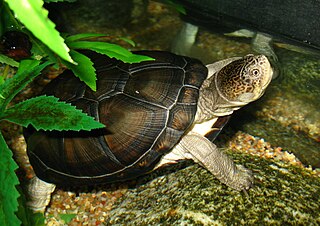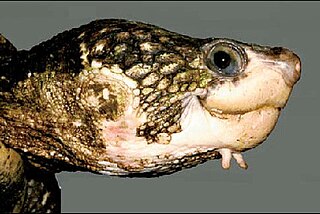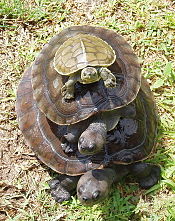
The Burmese star tortoise is a critically endangered tortoise species, native to the dry, deciduous forests of Myanmar (Burma). It is close to extinction in Myanmar, as it is eaten by the native Burmese.

The Arakan forest turtle is a critically endangered turtle species native to the Arakan Hills in western Myanmar and the bordering Chittagong Hill Tracts in Bangladesh. The Arakan forest turtle is a semiterrestrial turtle, meaning it can survive in aquatic as well as terrestrial habitats, but adults prefer living in terrestrial habitats.

The giant Asian pond turtle inhabits rivers, streams, marshes, and rice paddies from estuarine lowlands to moderate altitudes throughout Cambodia and Vietnam and in parts of Laos, Malaysia, Myanmar and Thailand.

The spiny turtle is a South-East Asian turtle species. It inhabits lowland and hill rainforest, usually dwelling in the vicinity of small streams in hill areas up to 1,000 m above sea level. It is found in Brunei, Indonesia, Malaysia, Myanmar, the Philippines, Singapore, and Thailand.

The elongated tortoise is a species of tortoise found in Southeast Asia and parts of South Asia.

The keeled box turtle is a species of turtle in the family Geoemydidae. The species is endemic to Asia.

The northern river terrapin is a species of riverine turtle native to Southeast Asia. It has been classified as Critically Endangered on the IUCN Red List and considered extinct in much of its former range; as of 2018, the population in the wild was estimated at 100 mature individuals.

The Amboina box turtle or Southeast Asian box turtle is a species of Asian box turtle widely distributed across Southeast Asia. It is native to the Asian mainland from northeast India, through Bangladesh, Burma and Thailand, across Laos, Cambodia, Vietnam, and Malaysia. It is also found on the archipelagos of Indonesia and the Philippines.

Oldham's leaf turtle is a species of turtle in the family Geoemydidae.

The red-crowned roofed turtle or Bengal roof turtle is a species of freshwater turtle endemic to South Asia. It was the type species of its former genus Kachuga. Females can grow to a shell length of 56 cm (22 in) and weigh 25 kilograms (55 lb), but males are considerably smaller. The turtles like to bask in the sun on land. In the breeding season, the heads and necks of male turtles exhibit bright red, yellow and blue coloration. The females excavate nests in which they lay clutches of up to thirty eggs.

The Chinese box turtle, also known as the yellow-margined box turtle, or golden-headed turtle, is a species of Asian box turtle. Taxonomically, it is called Cuora flavomarginata.

Pelusios is a genus of African side-necked turtles. With 17 described species, it is one of the most diverse genera of the turtle order (Testudines).

The Black-breasted leaf turtle, also commonly called the Vietnamese leaf turtle or the black-breasted hill turtle, a species of turtle. The species is listed as one of the smallest turtle species in the world. The species is endemic to Southeast Asia and is listed as endangered as of July 16, 2018.

The East African black mud turtle, also known as the Pan terrapin, is a species of turtle in the family Pelomedusidae, native to eastern and southeastern Africa.

Siebenrockiella crassicollis is a freshwater turtle endemic to Southeast Asia. It is one of two species classified under the genus Siebenrockiella in the family Geoemydidae.

Elseya albagula, commonly known as the white-throated snapping turtle, is one of the largest species of chelid turtles in the world, growing to about 45 cm (18 in) carapace length.

Batagur is a genus of large turtles from South and Southeast Asia. All members of the genus are seriously threatened. With a recent merger with members from two other genera, this genus has six described species.

The southern river terrapin is a riverine turtle of the family Geoemydidae found in Malaysia, Indonesia and Cambodia.
The Burmese narrow-headed softshell turtle, also known commonly as the Myanmar narrow-headed softshell turtle and Van Dijk's chitra, is a species of turtle in the family Trionychidae. The species is endemic to Southeast Asia.
Kalyar Platt is a Burmese herpetologist and turtle conservationist. She is the director of the Myanmar Program of the Turtle Survival Alliance and oversees conservation, breeding and reintroduction projects for some of Southeast Asia's rarest turtle species. She formerly worked for Wildlife Conservation Society and earned her PhD from Bangkok's Chulalongkorn University in 2007.




















